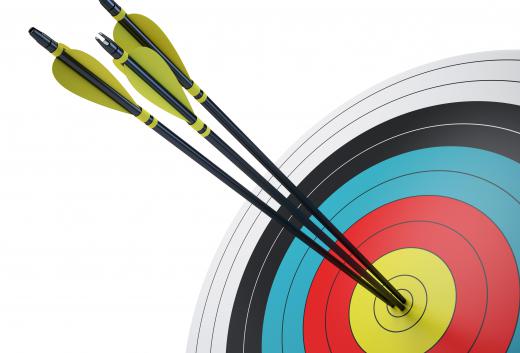Archery is a practice dating back at least 11000 years, to the Paleolithic area. The requirements of concentration, speed and accuracy have honed it over the years into artistry. If you would like to learn how archery for target practice or for hunting, you will need some basic equipment.
One of the most important items you will need is a bow. Experts recommend starting out with a traditional recurved or long bow, before moving on to more difficult weapons such as compound bows or crossbows. In choosing your bow, you will need to check the draw length, weight and length of the bow. You should be able to pull the string just behind your jaw, and the weight should feel comfortable. Recurve bows are usually the least expensive variety, and are generally priced between $50-$100 US Dollars (USD.)

Bows and arrows are an intricate team in archery, and your arrow selection will depend heavily on what type and size of bow you are using. Most modern arrows are made out of aluminum, although these are not recommended for use with long bows. Some manufacturers publish tables of bow and arrow matches. It is also possible to purchase a bow and arrow set, which included proper arrows for the included bow.

If you are learning to shoot, you will need a target to practice on. Most targets are either shaped like animals, or traditional concentric circles. These are generally made of a durable material that prevents damage to your arrows. There are a wide variety of targets available, with simple circle targets priced beginning at about $20-$30 USD. It is recommended that you start out with a large target, as most beginners will not have very good accuracy.

In terms of accessories, the beginner may want an arm guard, glove and chest protector. These archery items are generally made of leather or heavy fabric, and protect the body from accidental injury. Archery gloves have three fingers and basic models start at around $15 USD. Arm and chest guards are similarly priced.
To get a true Robin Hood feeling, you may wish to purchase a quiver to hold your arrows. These are generally leather or plastic, and strap on to your back, hip, or side. Prices for quivers vary widely, but most leather models begin at around $40 USD. Be warned that a quiver may throw off your balance at first, so you may wish to practice with it on to get used to it. You will also need to purchase extra bowstrings, as string may snap or break after many uses. These are generally inexpensive, usually costing less than $5 USD.
While it is not technically equipment, those learning archery must learn to pay close attention to safety precautions. Be sure to practice in a clear area that is distinctively marked for archery. Keep an eye out for any stray people or animals that may wander into your range, and never shoot when there is any obstacle in front of you. Before you begin practicing on your own, you may wish to take a few lessons to teach you proper form and technique. By being adequately prepared, you reduce the chance of injury and leave your mind free to concentrate on your shooting.
